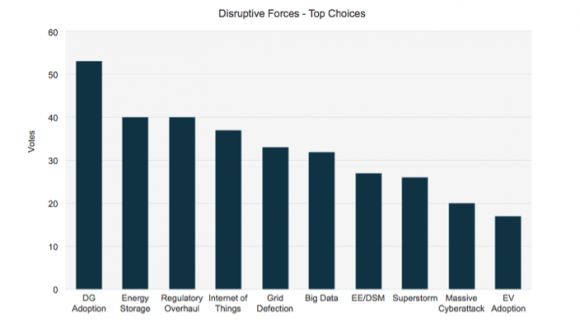The grid edge is a complex realm, combining traditional utility operations with the emerging world of distributed energy generation and control. Greentech Media’s inaugural Grid Edge Live conference, taking place this week in San Diego, is dedicated to finding solutions to these complex, emerging challenges.
One of the first steps in this process is deciding which challenges are most pressing and need to be tackled first. That’s the task that members of GTM Research’s Grid Edge Executive Council, a group of industry and research leaders, took on during a Monday pre-conference session, and here are the results.
Council members were asked to rank a list of ten disruptive factors, ranging from the rise of distributed generation and the potential for customers to defect from the grid, to the spread of customer-sited energy storage and plug-in electric vehicles, to system-wide concerns about securing the grid against extreme weather events and cyberattacks.
Rick Thompson, Greentech Media co-founder and president, revealed the results during Tuesday’s opening session at Grid Edge Live, along with a Top 5 list of disruptors that included some predictable responses -- and some surprises.

“The first three were, for me, relatively obvious,” Thompson said. First on the list by a long shot was the adoption of distributed generation (DG), primarily customer-sited solar PV, and its effects on grid stability and economics. The growth of customer-sited energy storage and overhauling regulations to allow new utility business models to manage these disruptive technologies took second and third place, respectively.
More surprising was seeing the growth of the “internet of things” and the threat of energy-independent customers defecting from the grid make the Top 5 list, he said. These issues beat out other pressing challenges, such as the massive increase in data that utilities are being asked to manage and the impact of weather events like Superstorm Sandy on grid reliability planning.
It’s important to note that not all of these Top 5 challenges are coming at the same speed. Council members were asked to expand their view of each disruptive factor, based both on the magnitude of their potential impact on the grid and how quickly they’re expected to become significant issues. The graph below charts the results, with the most quickly arising challenges standing high up on the vertical axis and the more slow-moving ones being farther down.

Clearly enough, “distributed generation is happening now,” Thompson said. “We have all seen that technologically it’s moving rapidly, becoming more efficient. Financially, the cost has been coming down. […] Clearly, the main barrier to rapid DG adoption is regulatory.” The threat of grid defection, by contrast, “is further out, if it ever grows beyond its niche,” he said.
Other insights from the council session include the view that confidence in customer-sited energy storage is growing from a technological and economic perspective, which “tells me that it’s right on the cusp of taking off,” Thompson said. That view is borne out by GTM Research’s work on distributed energy storage’s market potential. As for how to address these Top 5 challenges, stay tuned for updates over the next two days at Grid Edge Live.



